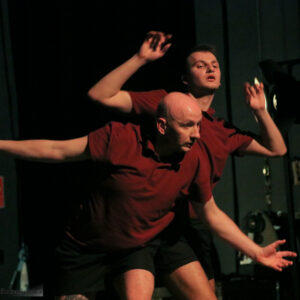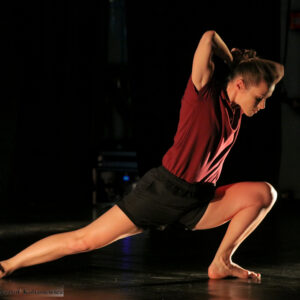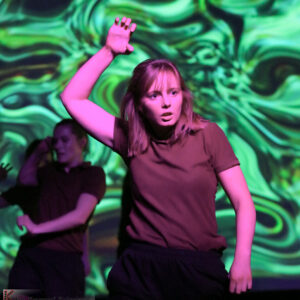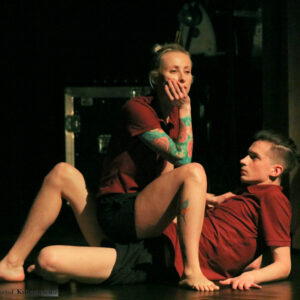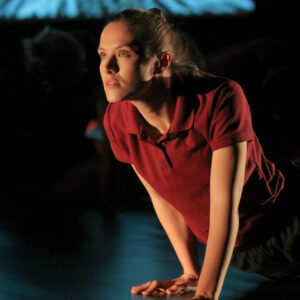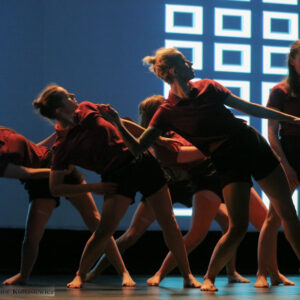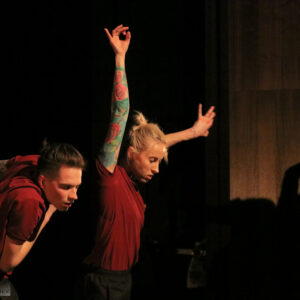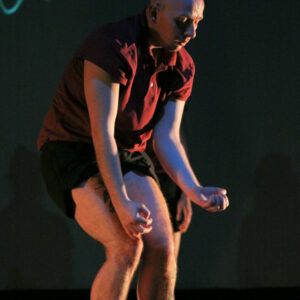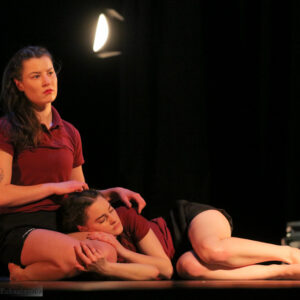Self-portrait from existential puzzles
"Stamina" - chorus Marek Zadłużny - Studio of the Dance Theater in Zielona Góra
Last weekend, the audience and the stage of the Nowosolski House of Culture were filled with artists and enthusiasts of dance, movement and physical theater who came to Sphere of Movement from all over Poland to exchange experiences, participate in workshops, discuss, inspire each other and watch the effects of their creative work.
For me, the impulse to come was the prospect of watching the performance of "Stamina" by Pracownia Teatr Tańca in Zielona Góra, which I have been following for several years. Let my reflections after the festival be opened by a short analysis of this spectacle. I invite you to the next text.
"Stamina" opens with a scene in which one of the dancers circles the others - gathered in a group - walking along a square line. This may suggest that everything that happens in a moment within the delineated area will be going on in her head, and locked in In this space, the dancers represent the individual selves of the protagonist - her different faces and parts of her personality. This theory is additionally supported by the fact that the dancers are dressed in the same costumes. which environment has not yet matured. This process usually manifests itself through isolation and searching for new perspectives of viewing reality. One thing is known for sure - the mentioned circulation is a prelude to the breakdown and further disintegration of a person or a whole group of people,caused by a mental breakdown.
This crisis comes suddenly. It falls down without warning, which the dancers emphasize by swinging, moving from a standing position to the ground floor and making sudden, hysterical movements accompanied by strong musical blows. Each of the actors expresses states of tension and progressive fragmentation in an individualized form (just as the causes and effects of the disability they feel may be different), but they share a common experience. Meanwhile, intriguing visuals by Joanna Fuczko appear behind their backs. Initially, these are successive squares, consistently multiplying and disassembling into parts. Later, they are replaced by a graphic image of the structure of DNA, which seems to indicate that the disintegration we observe is inherent in human nature and is a condition for its further development.You can see here the inspiration from Kazimierz Dąbrowski's theory of positive disintegration, which the dancers themselves pointed to in the announcements of the performance. Finally, disturbing moons (or some unspecified planets) appear on the screen. Their advent calls for the awakening of the hitherto dormant self - the wolf. Like Melancholy approaching Earth in the famous film by Lars von Trier, they are a signal of the approaching defeat, and thus a call to action and fight against adversities and with yourself. They initiate the "fight or flight" mechanism, and the heroes decide to take up the challenge. But how much are we able to carry? alternately crouching on the floor, lunging for a run and falling out of breath.
In the end, two of them are holding hands, as if to emphasize that experiencing the crisis has brought them closer together and has taught them to build deeper relationships. But understanding the nature of human relationships is only one of the stages of entering the higher planes of consciousness. As the battles are fought, the heroes (or the heroine) seem to see and comprehend more and more. Their transformation takes place slowly, which is again suggested by the recipients (well-composed and thought-out) visualizations. The images associated with the image of luminous, divine harmony are superimposed for fractions of a second by repulsive frames showing decay and vermin. It is precisely this pure course of thought of the characters that is disturbed by the darkest recesses of their souls, bad memories, traumas and - the most inconspicuous killers - doubts. Finally, however, they manage to overcome them.The heroes (the heroine?) Find solace in a religious trance, which the dancers convey through a slow sequence of fluid, "euphoric" figures performed to the sounds of Maria Callas's "Ave Maria". Ecstasy arising from the achievement of the highest level of spiritual development soon becomes balanced by a dance to the rhythm of a much less "sublime" piece Ballads and romances, in which the words: "Take already leave what is bad / Rub the sequins of tears / A gust of wind will give us strength / We turn to dust what is bad. " This procedure helps to avoid unnecessary pathos and places the spectacle in the raw reality that is closer to us.Ecstasy arising from the achievement of the highest level of spiritual development soon becomes balanced by a dance to the rhythm of a much less "sublime" piece Ballads and romances, in which the words: "Take already leave what is bad / Rub the sequins of tears / A gust of wind will give us strength / We turn to dust what is bad. " This procedure helps to avoid unnecessary pathos and places the spectacle in the raw reality that is closer to us.Ecstasy arising from the achievement of the highest level of spiritual development soon becomes balanced by a dance to the rhythm of a much less "sublime" piece Ballads and romances, in which the words: "Take away what is bad / Rub the sequins of tears / A gust of wind will give us strength / We turn to dust what is bad. " This procedure helps to avoid unnecessary pathos and places the spectacle in the raw reality that is closer to us.
"Stamina" is a story about a difficult path to self-discovery and the strength that - paradoxically - we find in ourselves in a crisis, in the face of losses and devastating failures. When I recalled this dance composition the next day, I recalled a sentence read in one of Jonathan Carroll's books: recover lost pieces of yourself if you find and recognize them. " Isn't it just this process that we witness when watching "Stamina"? Personality particles that we once rejected, displaced character traits, neglected talents or paths abandoned halfway ... re-constructing your self-portrait, provided that we persistent enough. The upbuilding message of "Stamina" seems very necessary in the era of successin which even the smallest falls are raised to the rank of a life drama and hidden from the world for fear of exclusion.
For me, watching "Stamina" performed by the phenomenal dancers of the Zielona Góra PTT (Agnieszka Jodłowska, Magdalena Bębenek, Kalina Grupa, Kinga Górska, Natalia Zaleszczak, Martyna Blachowska, Agata Kierońska, Marek Zadłużny, Radosław Bajon and Gabriel Zaborniak) gave something else - confirmation that stubbornness, consistency, and most importantly, hard work against everything and everyone always brings results.
Agnieszka Moroz
The Theater Journal
on March 29, 2019

